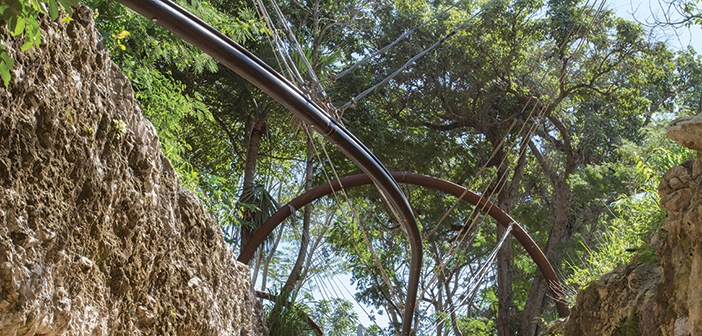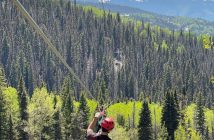Here’s a look at four variations.
AVATARONE
Main Attractions’ AvatarOne can launch up to 60 riders per hour, depending on course length and design.
The first installation of a twisted rail zip ride in the U.S. debuted in 2012 when Forever Florida, an eco-tourism park near Orlando, installed an AvatarOne ride dubbed The Rattlesnake. Termed “The only zip line roller coaster in the U.S.,” the ride launches from a 65-foot tower and follows a 1,200-foot-long rail that includes 11 vertical elements and five turns. To this day, it remains the only such attraction in the country.
Steve Wagner, VP of dynamic ride systems and development for Main Attractions, which manufactures AvatarOne, calls the Forever Florida installation “our beta test site to see what we could do to improve not only the ride experience, but also make it more affordable in installation and operation.”
Mission accomplished. “We have been able to smooth out the dynamic elements to allow for larger drops and dips, but also created a smoother ride experience,” he says. AvatarOne is capable of 24-foot vertical drops and rises, with larger elements currently being tested. Other improvements include available camera mounts, so operators can install action cams and sell photos to their customers, and a new braking system to allow for faster speeds at the end of the ride.
AvatarOne is capable of launching 60 riders per hour on a typical course, but that number varies depending on length and design. Wagner says that whatever the configuration, it is “designed to meet and exceed ASTM standards, welding practices, installation methods, and testing procedures.”
Currently there are seven AvatarOne installations in the world, including ones in Mexico, South Korea, and the Philippines, with additional installations planned in the U.S., China, and Europe.
FLY-LINE

Outdoor Ventures’ Fly-Line features a speed-limiting centrifugal brake built into the trolley, so riders descend the entire track at the same speed regardless of weight.
This product twists and turns through the forest canopy at a speed that allows riders to enjoy the surrounding views and natural beauty. Created by an Italian company, Fly-Line offers a bit of a different experience than its adrenaline infused counterparts. It has a speed-limiting centrifugal brake built into the trolley, so riders descend the entire track at the same 15 mph speed regardless of weight. This predictability allows operators to send riders every 15 to 20 seconds, which translates into a throughput of 200 people per hour. “This is truly a ‘rolling canopy tour,’” says Dave Horan of Outdoor Ventures, which represents Fly-Line in the U.S.
In addition to high capacity, a second benefit is the inclusive nature of the ride. “It’s for the entire family. As long as you fit in the harness, you can go,” Horan says. (Up to a point: it does have a max weight limit.) “With big zips, there are barriers like minimum and maximum height and weight requirements, minimum age restrictions, the fear factor—this all contributes to a ride that often excludes a member or two from any group.” These are less of an issue with the Fly-Line.
According to Horan, a typical ride is five to eight minutes long. The line height above the ground can vary from a few to hundreds of feet. While the speed may not get the heart pumping, the sensation of dynamic flight high off the ground certainly can.






